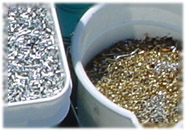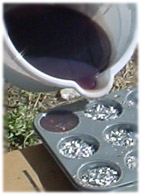Overview
Basic orgonite is simply fiberglass resin, metal shavings and a quartz
crystal, cured in any mold you like. There's no one "right" shape or
size for orgonite, and its range of effect seems to scale linearly with
volume, but there are specific, time-tested, widely-used and
repeatedly-confirmed effective designs for both personal and field
devices which have grown and continue to grow out of the steadfast work
of talented and dedicated gifters from around the world. These designs
comprise the basic tools of the orgonite gifter as discussed on numerous
orgonite Web boards and offered pre-made by many
reputable orgonite vendors.
What You'll Need
Metal Shavings: 
You don't want fine metal filings, nor do you want large pieces of
metal. Quarter-inch-wide aluminum curls are very common and very
effective for use in orgonite, but any kind of copper, iron, brass
(including brassed aluminum), bronze, nickel or even steel shavings will
work fine. Just bring a bucket and some work gloves to a local machine
shop and ask them if you can fill your bucket with metal shavings.
Before giving them to you for free, they will probably ask you what it's
for (typically more out of curiosity than anything), so why not tell
them? If you don't feel comfortable explaining orgonite to them, simply
tell them about this site,
or give them the simplest honest answer you can, such as a "public
service," "art project," or even "science experiement". However, you
may be surprised what people will understand if you take the time to
explain it meaningfully and from the heart.
 Quartz Crystals:
Quartz Crystals:
Any funky, ugly, smokey pieces of quartz will work perfectly for
orgonite field devices. You can usually find this grade of quartz
crystal very inexpensively at most decent gem and mineral shops, or you
can
buy quartz online from orgonite-aware vendors at appropriate sizes and grades.
 Fiberglass/Epoxy Resin:
Fiberglass/Epoxy Resin:
The most expensive component of orgonite, typically retailing for
US$75-$100/gallon at marine supply stores and hardware stores. Any kind
of organic resin will work fine, but liquid resin (as opposed to "body
fill" paste) has been found to be easiest to work with for creating
orgonite. Resin requires a chemical additive called a hardener,
typically included if purchased by the gallon, in order to catalyze the
curing (hardening) process, which may take from mere hours in hot, arid
weather to multiple days in wet, cold weather.
Molds: This depends on the specific type of orgonite device you
wish to create, but any mold which can withstand boiling temperatures
should work fine. Avoid plastics unless they are oven-safe, as the
chemical reaction which occurs during the catalyzation process heats the
resin to temperatures which can easily melt normal plastics.
Generally, metal molds seem to work best for most purposes, but cheap
field devices can also be made from large paper bathroom cups or paper
sno-cone cups.
Use your imagination!
Other Stuff: You will want a mixing container such as a bucket
(preferably with a pouring lip), a wooden stirring stick, some old rags
or paper towels for splashes and spills, and a large, flat surface for
leaving the orgonite to cure.
Safety: Organic resins emit toxic fumes before and during the
curing process, so working in a well-ventilated area such as a backyard
or porch/deck is ideal. You may also want to use protective gloves and
wear clothing you don't mind getting catalyzed resin splashed on, as it
will
go everywhere, especially your first few times pouring. Putting down a
tarp first can help tremendously with cleanup, as the hardened resin
should pop right off the tarp.
Common Orgonite Designs




 You don't want fine metal filings, nor do you want large pieces of
metal. Quarter-inch-wide aluminum curls are very common and very
effective for use in orgonite, but any kind of copper, iron, brass
(including brassed aluminum), bronze, nickel or even steel shavings will
work fine. Just bring a bucket and some work gloves to a local machine
shop and ask them if you can fill your bucket with metal shavings.
Before giving them to you for free, they will probably ask you what it's
for (typically more out of curiosity than anything), so why not tell
them? If you don't feel comfortable explaining orgonite to them, simply
tell them about this site,
or give them the simplest honest answer you can, such as a "public
service," "art project," or even "science experiement". However, you
may be surprised what people will understand if you take the time to
explain it meaningfully and from the heart.
You don't want fine metal filings, nor do you want large pieces of
metal. Quarter-inch-wide aluminum curls are very common and very
effective for use in orgonite, but any kind of copper, iron, brass
(including brassed aluminum), bronze, nickel or even steel shavings will
work fine. Just bring a bucket and some work gloves to a local machine
shop and ask them if you can fill your bucket with metal shavings.
Before giving them to you for free, they will probably ask you what it's
for (typically more out of curiosity than anything), so why not tell
them? If you don't feel comfortable explaining orgonite to them, simply
tell them about this site,
or give them the simplest honest answer you can, such as a "public
service," "art project," or even "science experiement". However, you
may be surprised what people will understand if you take the time to
explain it meaningfully and from the heart. Quartz Crystals:
Any funky, ugly, smokey pieces of quartz will work perfectly for
orgonite field devices. You can usually find this grade of quartz
crystal very inexpensively at most decent gem and mineral shops, or you
can buy quartz online from orgonite-aware vendors at appropriate sizes and grades.
Quartz Crystals:
Any funky, ugly, smokey pieces of quartz will work perfectly for
orgonite field devices. You can usually find this grade of quartz
crystal very inexpensively at most decent gem and mineral shops, or you
can buy quartz online from orgonite-aware vendors at appropriate sizes and grades. Fiberglass/Epoxy Resin:
The most expensive component of orgonite, typically retailing for
US$75-$100/gallon at marine supply stores and hardware stores. Any kind
of organic resin will work fine, but liquid resin (as opposed to "body
fill" paste) has been found to be easiest to work with for creating
orgonite. Resin requires a chemical additive called a hardener,
typically included if purchased by the gallon, in order to catalyze the
curing (hardening) process, which may take from mere hours in hot, arid
weather to multiple days in wet, cold weather.
Fiberglass/Epoxy Resin:
The most expensive component of orgonite, typically retailing for
US$75-$100/gallon at marine supply stores and hardware stores. Any kind
of organic resin will work fine, but liquid resin (as opposed to "body
fill" paste) has been found to be easiest to work with for creating
orgonite. Resin requires a chemical additive called a hardener,
typically included if purchased by the gallon, in order to catalyze the
curing (hardening) process, which may take from mere hours in hot, arid
weather to multiple days in wet, cold weather.